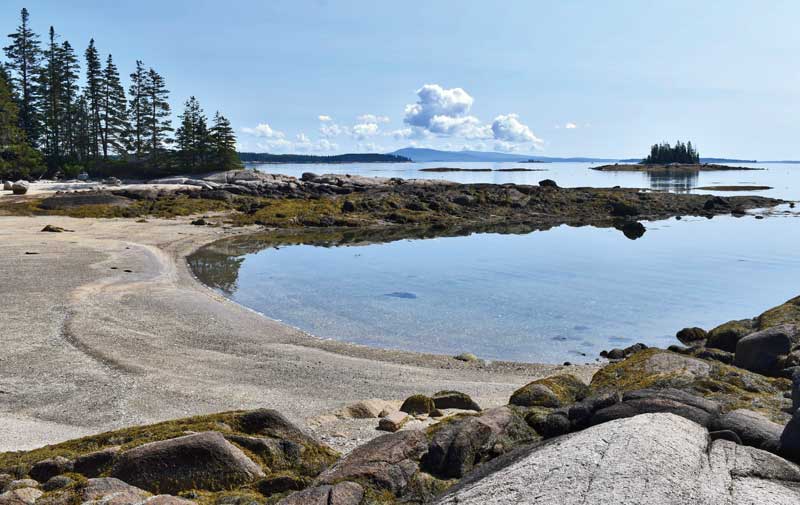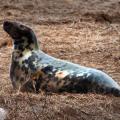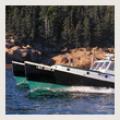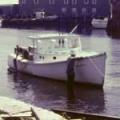Community Rallies to Save a Jewel
All photos by Steele Hays
 Looking east by northeast toward Mount Desert Island from Sheep Island.
Looking east by northeast toward Mount Desert Island from Sheep Island.
It’s a bijou island—a jewel. Many people who’ve visited scores of Maine’s uninhabited islands say that it’s one of their favorites. And now Sheep Island is protected and accessible for public use forever.
You may have trouble finding it… because there are 23 Sheep Islands in Maine, according to the Maine Coastal Island Registry. This one is just east of Deer Isle’s Stinson Neck. It’s just seven acres in size, but it packs an amazing amount of scenic beauty and natural features into that diminutive space, with huge granite glacial erratic boulders perched on its shores, a tidal bar of crushed shells linking the main island to a tiny islet at low tide, grassy meadows interspersed with dark spruce trees covered in lichen, and a huge midden built up over centuries of use by indigenous people who visited the island to harvest shellfish, fish, and waterfowl.
 Green crabs are plentiful in the shallow waters.
Green crabs are plentiful in the shallow waters.
In the late 1990s, several conservationists felt that Sheep Island was under threat. Its private landowner had allowed it to be listed on the Maine Island Trail as open to public use, and had granted a conservation easement to Acadia National Park, but there had been squatters on the island and ANP directed the owner to clean up the squatter’s camp and meet other requirements to maintain the island’s natural character. Worried about these caretaking mandates, the owner threatened to sell the island and/or end public access.
To preserve public access and protect the island, several Maine Island Trail volunteer leaders and employees reached into their own pockets to buy the island. The price was modest: $12,000, less than $2,000 per acre.
“Our whole purpose was to avoid the loss of the island for public use and avoid seeing it wrecked,” said Sid Quarrier, a retired geologist and one of the organizers of the group. Earlier this year, Quarrier and other members of the group, who are all in their 70s or 80s now, took another step to protect Sheep Island. They’ve donated it to the Island Heritage Trust of Deer Isle. It will continue to be listed with MITA and will remain open for both day use and overnight stays.
 This sand bar links Sheep and its smaller neighbor for several hours every tide cycle.
This sand bar links Sheep and its smaller neighbor for several hours every tide cycle.
Sheep is one of the 258 islands on the Maine Island Trail. Fifty-seven are privately owned, 102 are owned by nonprofit groups, and 100 are owned by the state or local governments.
When the kayaking popularity boom happened in the 1990s and early 2000s, there was a risk that the increased pressure would cause some private owners to pull out of the Maine Island Trail system. A few did, but the organization has learned from that experience and adopted new strategies to address the risk, such as making sure its communications and relationships with private island owners (who are often families) reach everyone with an ownership stake, not just one point of contact. The results are encouraging. Since 2012, MITA has added eight private islands to the trail and has only lost two islands—and those were both caused by a change in ownership.
Attitudes by recreational users of MITA islands have evolved as well in the last decade, according to MITA program director Brian Marcaurelle. “Trail users have more recognition that access is a privilege, not a right. They’re more aware of their responsibilities to be good stewards. This is a good thing.”
When MITA volunteers conduct their annual or biannual island clean-up efforts now, refuse left by campers or day users is not the primary problem. Far more of the waste is plastic of all sorts washed onto the islands—much of it lost, discarded, and storm-tossed materials from the fishing industry: lobster buoys, line, Styrofoam, and other items.
It’s easy to see why indigenous people visited Sheep Island centuries ago. As your boat approaches the beach linking Sheep and its little islet, the water grows shallow. The smooth sand and mud bottom is covered by countless clam, mussel, and oyster shells. On a recent early morning visit, the sea was so perfectly mirror smooth that the gently rising tide had turned thousands of empty shells into tiny boats floating on the surface—an amazing sight made possible by nature and by efforts to preserve and protect.
Steele Hays lives in Blue Hill and is a part-time marketing executive and writer.
Related Articles
Share this article:
2023 Maine Boat & Home Show

Join Us for the Maine Boat & Home Show!
Art, Artisans, Food, Fun & Boats, Boats, Boats
August 11 - 13, 2023 | On the waterfront, Rockland, Maine
Click here to pre-order your tickets.
Show is produced by Maine Boats, Homes & Harbors magazine.















